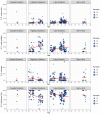Plasmodium interspecies interactions during a period of increasing prevalence of Plasmodium ovale in symptomatic individuals seeking treatment: an observational study
- PMID: 35544189
- PMCID: PMC7613221
- DOI: 10.1016/S2666-5247(21)00009-4
Plasmodium interspecies interactions during a period of increasing prevalence of Plasmodium ovale in symptomatic individuals seeking treatment: an observational study
Abstract
Background: The epidemiology and severity of non-falciparum malaria in endemic settings has garnered little attention. We aimed to characterise the prevalence, interaction, clinical risk factors, and temporal trends of non-falciparum Plasmodium species among symptomatic individuals presenting at health-care facilities in endemic settings of Kenya.
Methods: We diagnosed and analysed infecting malaria species (Plasmodium falciparum, Plasmodium ovale curtisi, Plasmodium ovale wallikeri, and Plasmodium malariae) via PCR in clinical samples collected between March 1, 2008, and Dec 31, 2016, from six hospitals located in different regions of Kenya. We recruited patients aged 6 months or older who presented at outpatient departments with symptoms of malaria or tested positive for uncomplicated malaria by malaria rapid diagnostic test. Descriptive statistics were used to describe the prevalence and distribution of Plasmodium species. A statistical model was designed and used for estimating the frequency of Plasmodium species and assessing interspecies interactions. Mixed-effect linear regression models with random slopes for each location were used to test for change in prevalence over time.
Findings: Samples from 2027 symptomatic participants presenting at care facilities were successfully analysed for all Plasmodium species. 1469 (72·5%) of the samples were P falciparum single-species infections, 523 (25·8%) were mixed infections, and only 35 (1·7%) were single non-falciparum species infections. 452 (22·3%) were mixed infections containing P ovale spp. A likelihood-based model calculation of the population frequency of each species estimated a significant within-host interference between P falciparum and P ovale curtisi. Mixed-effect logistic regression models identified a significant increase in P ovale wallikeri (2·1% per year; p=0·043) and P ovale curtisi (0·7% per year; p=0·0002) species over time, with a reciprocal decrease in P falciparum single-species infections (2·5% per year; p=0·0065). The frequency of P malariae infections did not significantly change over time. Risk of P falciparum infections presenting with fever was lower if co-infected with P malariae (adjusted odds ratio 0·43, 95% CI 0·25-0·74; p=0·0023).
Interpretation: Our results show a prevalence of non-falciparum species infections of 27·5% among symptomatic individuals presenting at care facilities, which is higher than expected from previous cross-sectional surveys. The proportion of infections with P ovale wallikeri and P ovale curtisi was observed to significantly increase over the period of study, which could be due to attenuated responsiveness of these species to malaria drug treatment. The increase in frequency of P ovale spp could threaten the malaria control efforts in Kenya and pose increased risk of malaria to travellers.
Funding: Armed Forces Health Surveillance Branch and its Global Emerging Infections Surveillance Section.
Copyright © 2021 The Author(s). Published by Elsevier Ltd. This is an Open Access article under the CC BY-NC-ND 4.0 license. Published by Elsevier Ltd.. All rights reserved.
Conflict of interest statement
We HMA, DWJ, BHO, ROO, GCC, JAJ, EWM, ACC, RAY, MNM, COO, BA, JRM, BRO, KKM, OW, RV, DPK, LAI, NB and EK declare no competing interests
Figures




References
-
- Wongsrichanalai C, Barcus MJ, Muth S, Sutamihardja A, Wernsdorfer WH. A review of malaria diagnostic tools: microscopy and rapid diagnostic test (RDT) Am J Trop Med Hyg. 2007;77(6 Suppl):119–27. - PubMed
Publication types
MeSH terms
Grants and funding
LinkOut - more resources
Full Text Sources
Medical
Research Materials
Miscellaneous

